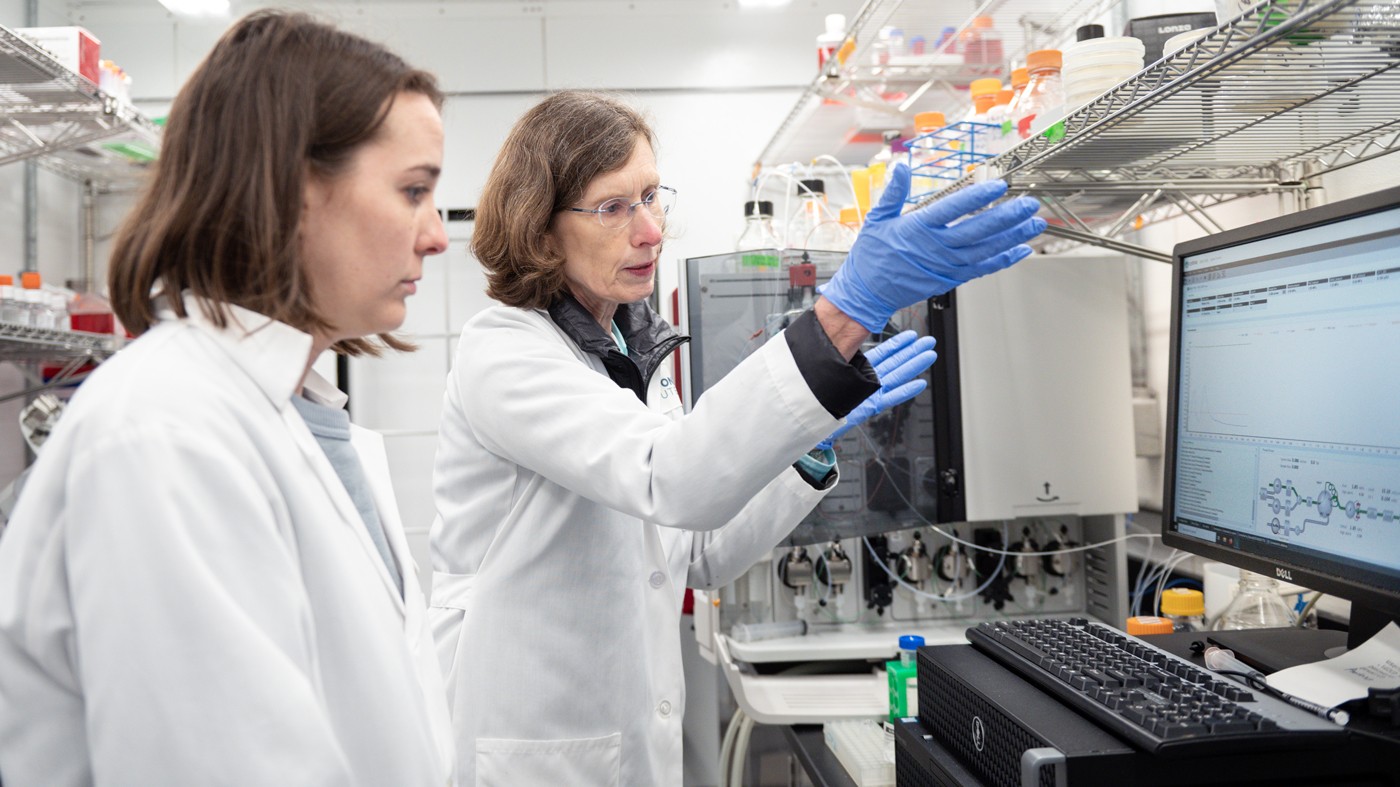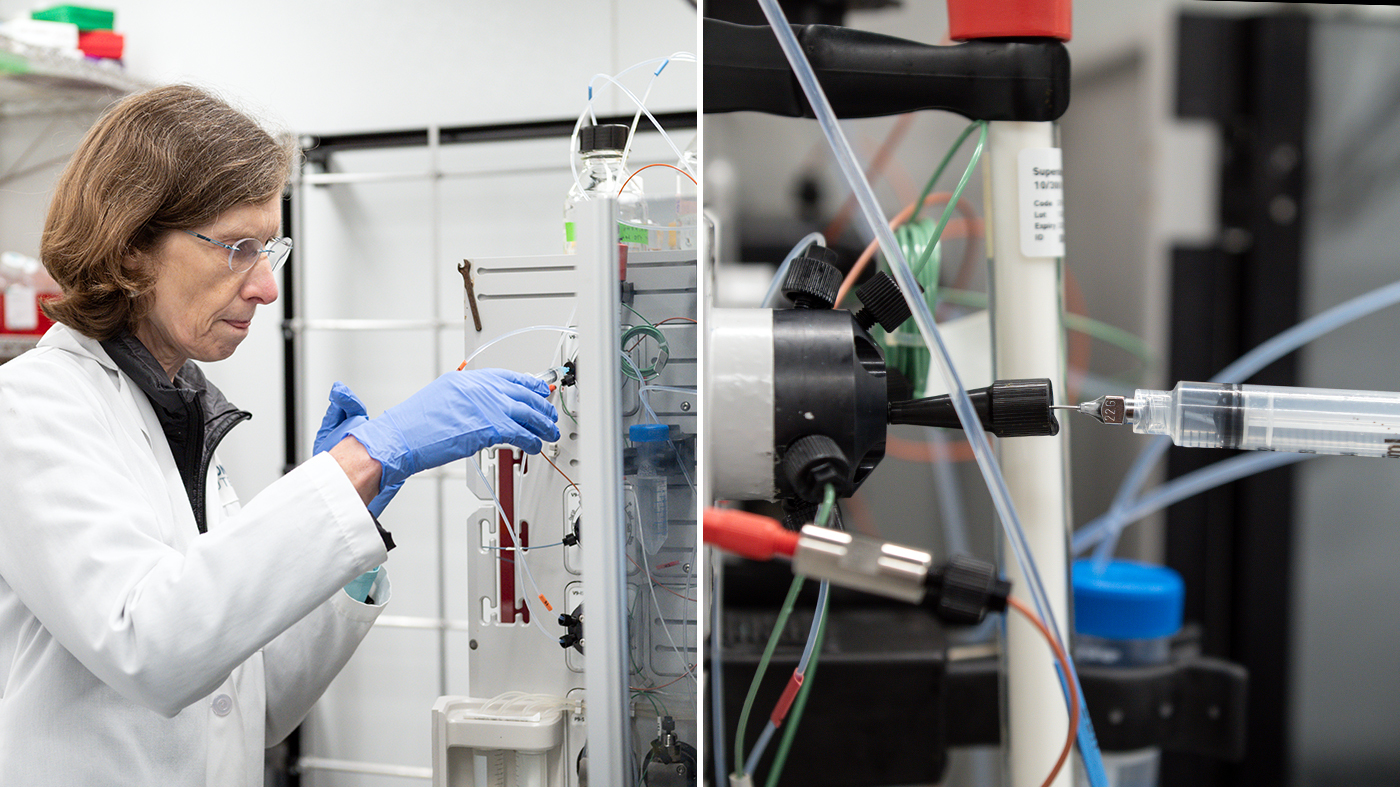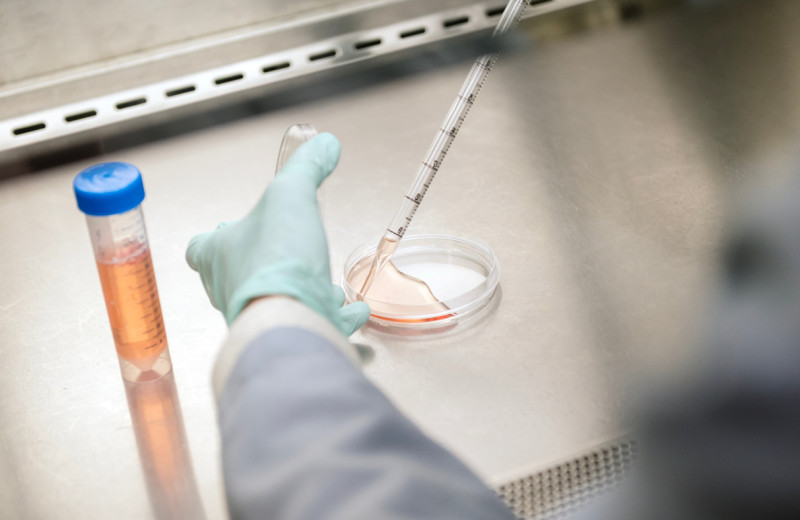Gladstone NOW: The Campaign Join Us on the Journey✕

Ursula Schulze-Gahmen (right) and her collaborators shed light on the biological effect of the many possible three-dimensional structures of a critical loop of RNA in HIV. Shown here working with Research Associate Maria McCavitt-Malvido (left).
To spread between cells in the body and hop from person to person, human immunodeficiency virus (HIV) must copy its genetic material, produce viral proteins, and assemble new virus particles. For this complex process to occur, a viral protein called Tat must bind to a section of the virus’s RNA—the molecules that carry instructions for making new proteins—which is called the HIV trans-activation response element (TAR).
The TAR RNA can assume many different shapes, known as conformations. However, the Tat protein can only bind to one of these conformations, and if TAR is in a conformation that does not bind to Tat, HIV won’t replicate. So, understanding how these molecules interact could help scientists design therapies that block HIV replication.
Now, researchers at Gladstone Institutes, Columbia University, Stanford University, Johns Hopkins University, and Duke University School of Medicine have collaborated to better understand the role of the many three-dimensional conformations of the TAR RNA, and how these conformations impact its ability to bind to Tat and initiate HIV replication. Their findings could eventually lead to HIV drugs that stabilize certain forms of the RNA and prevent interactions with Tat.

Ursula Schulze-Gahmen was part of a team of researchers that measured the entire ensemble of TAR structures to determine the probability for each conformation of binding to Tat and activating HIV transcription.
The new work was published in the journal Nature and led by Hashim Al Hashimi, PhD, professor of biochemistry and molecular biophysics at Columbia University, in collaboration with Daniel Herschlag, PhD, at Stanford, Bryan Cullen, PhD, at Duke, and Ursula Schulze-Gahmen, PhD, a senior staff research scientist at Gladstone. We sat down with Schulze-Gahmen to hear more about the research.
Why Are You and Your Collaborators Interested in TAR?
TAR is a critical piece of the machinery that controls HIV replication. When viral transcription [the process of turning on the virus' genes] begins, HIV forms a small TAR RNA loop. Then, to successfully complete the transcription process, Tat binds to this TAR loop and recruits other proteins that make viral transcription efficient. We want to better understand these molecular interactions so we can target them for drug development.
There’s Been a Lot of Work on TAR RNA in the Past. What Made This Study So Different?
When researchers set out to understand the structural biology of a molecule like TAR, they typically use techniques that yield static images, which show the shape of molecules before and after binding. In the past, people have studied what the TAR RNA looks like while in one particular complex with Tat. However, TAR can arrange itself in dozens of different ways—some of which bind to Tat, and some of which don’t.
To understand the role of TAR in cellular activity, it is important to know which conformation binds to Tat to enable transcription, and what energy is required for TAR to adopt that conformation. With that goal in mind, we set out to measure the entire ensemble of TAR structures to determine the probability for each conformation of binding to Tat and activating HIV transcription in the cell.

Schulze-Gahmen helped find a hidden mechanism for controlling the activity of TAR in a cell.
This Research Involved Researchers from Several Institutions. Why Was Collaboration So Critical?
This paper looks at a wide spectrum of information about TAR, all the way from the biophysics of the molecule and how different atoms within its structure interact, to how TAR and Tat induce viral transcription in living cells. It would have been difficult for one team to do all of that.
At Gladstone, I looked at the energetic cost of interactions between TAR variants and Tat bound to other proteins involved in transcription. We then used this data to understand how different conformations correlated with transcriptional activity.
What Did You Find When You Looked at All These Structures?
We found a hidden mechanism for controlling the activity of TAR in a cell. By making it energetically costly for TAR to adopt its biologically active state, we could modify the rate of viral transcription.
How Might These Findings Contribute to HIV Drug Development?
There have been studies in the past where scientists designed a peptide that bound tightly to the TAR RNA. They thought that would keep Tat from attaching to TAR and, as a result, inhibit transcription. But, to their surprise, the peptide had no effect on HIV transcription—the peptide actually stabilized TAR into a form that supports transcription.
With our work, we’re raising awareness that, when you look for drugs that target TAR, you have to consider all of its different structures. We are currently looking for drugs that can prevent TAR from adopting its active state and thereby prevent HIV from replicating.
Can This Same Approach Be Used to Better Understand Other RNA-Protein Interactions?
Absolutely. That’s a big focus of this work. In fact, most of the paper is not specifically about HIV, it’s about the idea that when you look at the interactions between an RNA and protein, or between two proteins, it’s important to consider the whole ensemble of structures that each molecule can adopt.
Because RNAs are generally more flexible than proteins, our approach of considering all conformations is even more important for RNA interactions. If we can improve our understanding and predict RNA conformations, we can help improve the development of drugs that target RNA and RNA-binding proteins.
The paper “RNA conformational propensities determine cellular activity” was published in the journal Nature on May 17, 2023. Other authors are: Megan L. Ken, Rohit Roy, Ainan Geng, and Akanksha Manghrani of Duke University School of Medicine; and Laura R. Ganser of Johns Hopkins University.
The work was supported by the National Institutes of Health (grants R01GM132899, U54AI150470, F30AI143282-01A1, 5R21AI156915 and UM1AI164559).
Gene Editing Strategy Could Treat Hundreds of Inherited Diseases More Effectively
Gene Editing Strategy Could Treat Hundreds of Inherited Diseases More Effectively
Scientists at Gladstone show the new method could treat the majority of patients with Charcot-Marie-Tooth disease.
News Release Research (Publication) Neurological Disease Conklin Lab CRISPR/Gene EditingGenomic Maps Untangle the Complex Roots of Disease
Genomic Maps Untangle the Complex Roots of Disease
Findings of the new study in Nature could streamline scientific discovery and accelerate drug development.
News Release Research (Publication) Marson Lab GenomicsThe Genome Editing Playbook Is Different in Neurons
The Genome Editing Playbook Is Different in Neurons
The striking findings of a new study could influence how gene therapies are designed for many genetic diseases.
News Release Research (Publication) Neurological Disease Conklin Lab Doudna Lab CRISPR/Gene Editing



